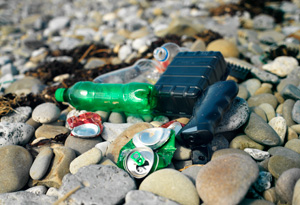Find Your Own "Plastiki"

Photo: Stockbyte/Thinkstock
Plastic is literally jamming up nature's code. The very durability that makes plastic so useful to humans is exactly what makes it incredibly harmful to all the natural life cycles in every ecosystem worldwide. When it comes to an accumulation of plastic in our oceans, David de Rothschild—expedition leader of the Plastiki, a boat made of 12,500 recycled plastic bottles—says the problem has gotten out of control.
For me, the stark reality of our planet's plastic situation really kicked in back in 2006 when I read the United Nations Environment Program publication, "Ecosystems and Biodiversity in Deep Waters and High Seas." The report pointed out that on or below every square mile of our ocean, there were 46,000 pieces of floating marine debris. The problem was particularly acute in certain areas.The most notorious of these areas, called the Eastern Garbage Patch, is a swirling gyre in the North Pacific twice the size of Texas. There, for every pound of plankton researchers found 6 pounds of plastic litter. Along with four other enormous gyres, these swirling heaps of trash now potentially cover up to 40 percent of our planet's surface. From ocean trenches in the Atlantic to floating particles across the farthest reaches of the Pacific, synthetic polymers are on a rampage: As much as 90 to 95 percent of the total amount of marine debris is plastic—the remaining 5 to 10 percent is slowly degrading materials such as timber and glass, as well as hazardous and hard-to-clean-up medical, industrial and raw-chemical sewage-related waste. The full effects of these man-made materials are still being fully assessed by the scientific community; however, it's safe to say that almost every fish, marine mammal, sea bird and even human is or will be affected in one way or another.
Take the case of the majestic and now endangered albatross. The Laysan albatrosses that nest on Kure Atoll and Oahu Hawaii get it the worst. They mistake floating plastic items such as fishing line, light sticks and lighters for squid, fish and krill. Scientific American printed a quote from Lindsay Young of the University of Hawaii that sums it up well: "There were so many small plastic toys in the birds from Kure Atoll...that we could have assembled a complete nativity scene with them." It's estimated that of the 500,000 albatross chicks born every year on Midway, almost half of them die from consuming plastic fed to them by their parents. One was found to have 306 pieces of plastic inside of its belly.
But even more ominous is the second major issue regarding the spreading plastic plague: toxicity transference.



